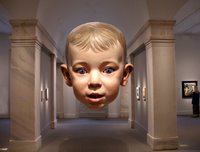 NATIONAL PORTRAIT GALLERY
NATIONAL PORTRAIT GALLERYTHE SMITHSONIAN AMERICAN ART MUSEUM
The National Portrait Gallery and the Smithsonian American Art Museum reopened last year after being closed five years for renovation. The building, which Walt Whitman called the most beautiful in Washington, was the Government Patent Office Building until the Smithsonian Institution saved it from demolition in the 1950s.The renovation has turned it into what can certainly be called one of the most beautiful buildings in Washington, if it is not indeed the most beautiful. It is filled with some of the most wonderful art in the world.

Along with appropriate attention to restoring and enhancing architectural features of the old building, special care was taken to preserve evidence that the place had been touched by ordinary Americans. An unidentified person carved the initials “C.H.F,” and the date, “August 8, 1864,” in a window sill. That date marks a troubled time in the history of the nation and of Washington, D.C. The Civil War was in its third long year, and the city was flooded with Union troops, both those defending the capital and those being treated for wounds from previous battles. Perhaps the initials were carved by a wounded Union soldier. The carved initials are now protected under plexiglass and have been given an exhibit marker.

Washington, D.C., including the Patent Office Building, was traumatized by the Civil War. In the early days of the conflict the soldiers of the First Rhode Island Regiment were quartered in the west wing of the Patent Office. Manassas, Antietam, and Fredericksburg battles were fought nearby, and the wounded were brought to the military hospital that had been set up in the Patent Office. As many as three thousand beds were set up in the east, west, and north exhibition galleries. President and Mrs. Lincoln visited the wounded soldiers housed in these halls. So did Walt Whitman. Clara Barton, who went on to found the American Red Cross, interrupted her duties as a clerk at the Patent Office to serve the wounded.

From 1861 to 1863 Whitman tended soldiers there when the top floor served as hospital. “It was a strange, solemn sight,” he wrote, “the glass (model) cases, the beds, the forms lying there, the gallery above, and the marble pavement under foot.”
In 1865 Whitman worked for a time as a clerk in the Indian Affairs Bureau located in the building. He was working there at the time of Lincoln’s second inaugural ball: “I have been up to look at the dance and supper rooms...What a different scene they presented to my (earlier) view, filled with a crowded mass of the worst wounded of the war. Tonight, beautiful women, perfumes, the violins’ sweetness, the polka and the waltz; then the amputation, the blue face, the groan, the glassy eye of the dying.”

Whitman was dismissed from his position at Indian Affairs when Interior Secretary James Harlan discovered that he was the author of Leaves of Grass. Harlan declared that the book was “indecent.”

No comments:
Post a Comment